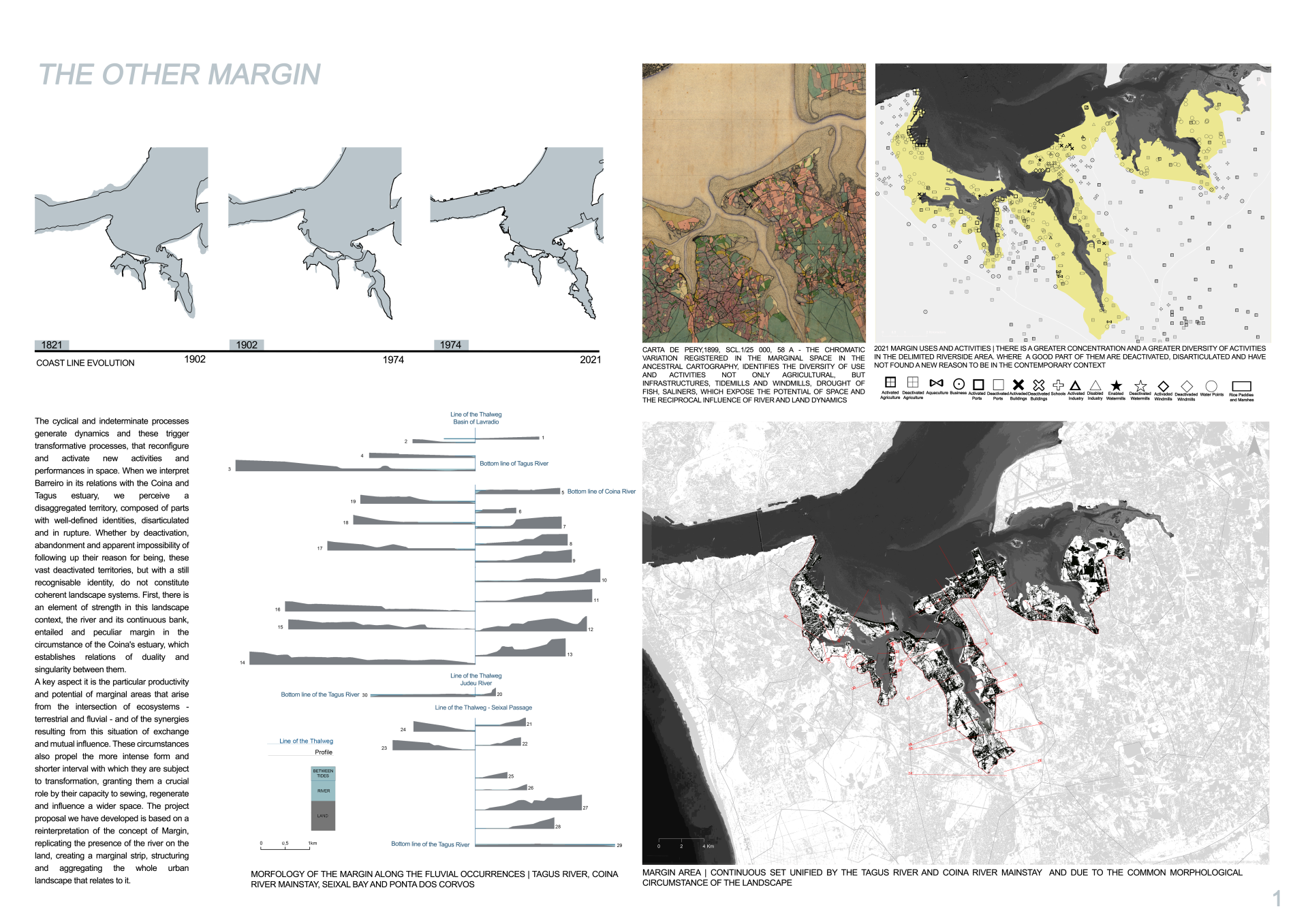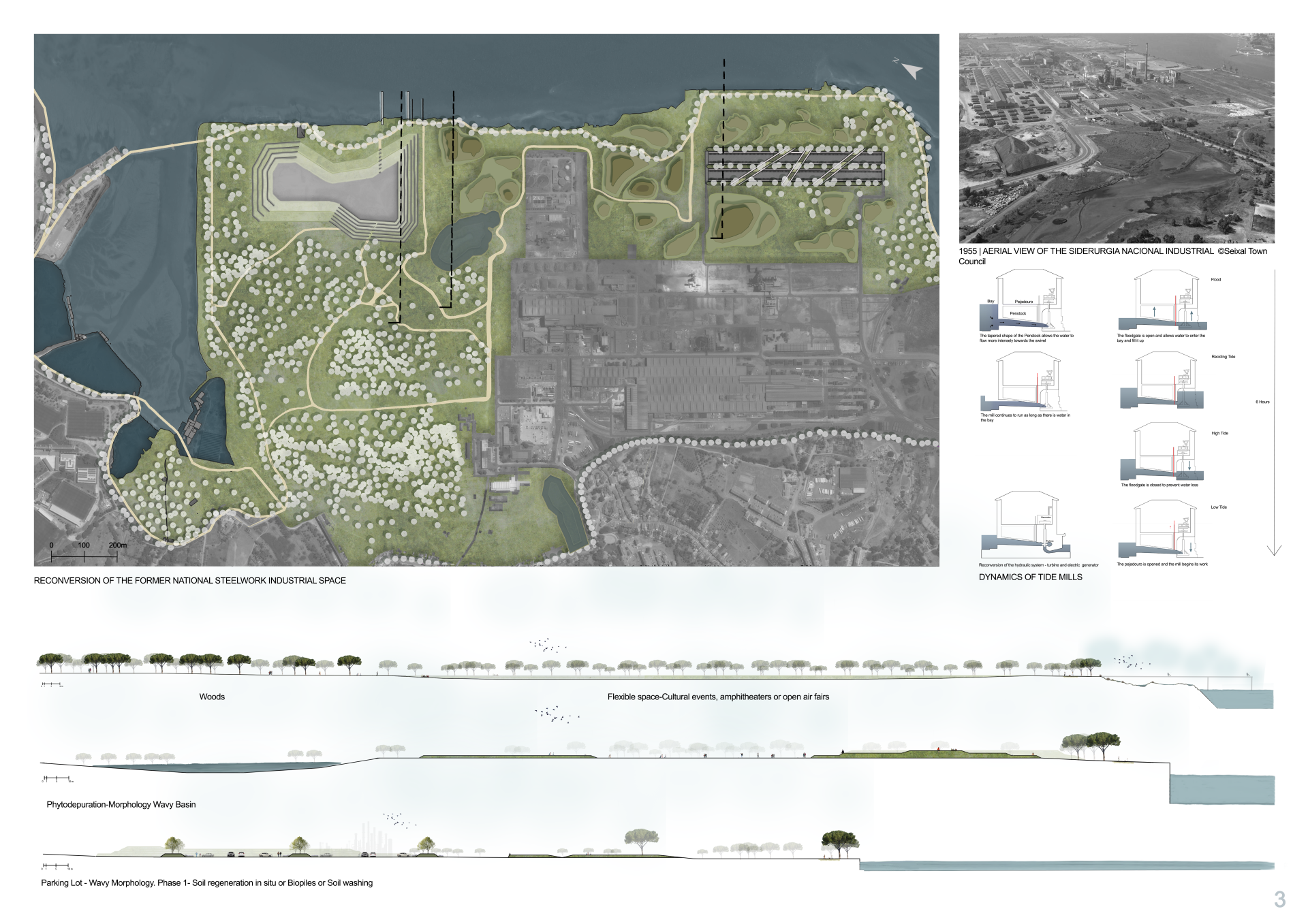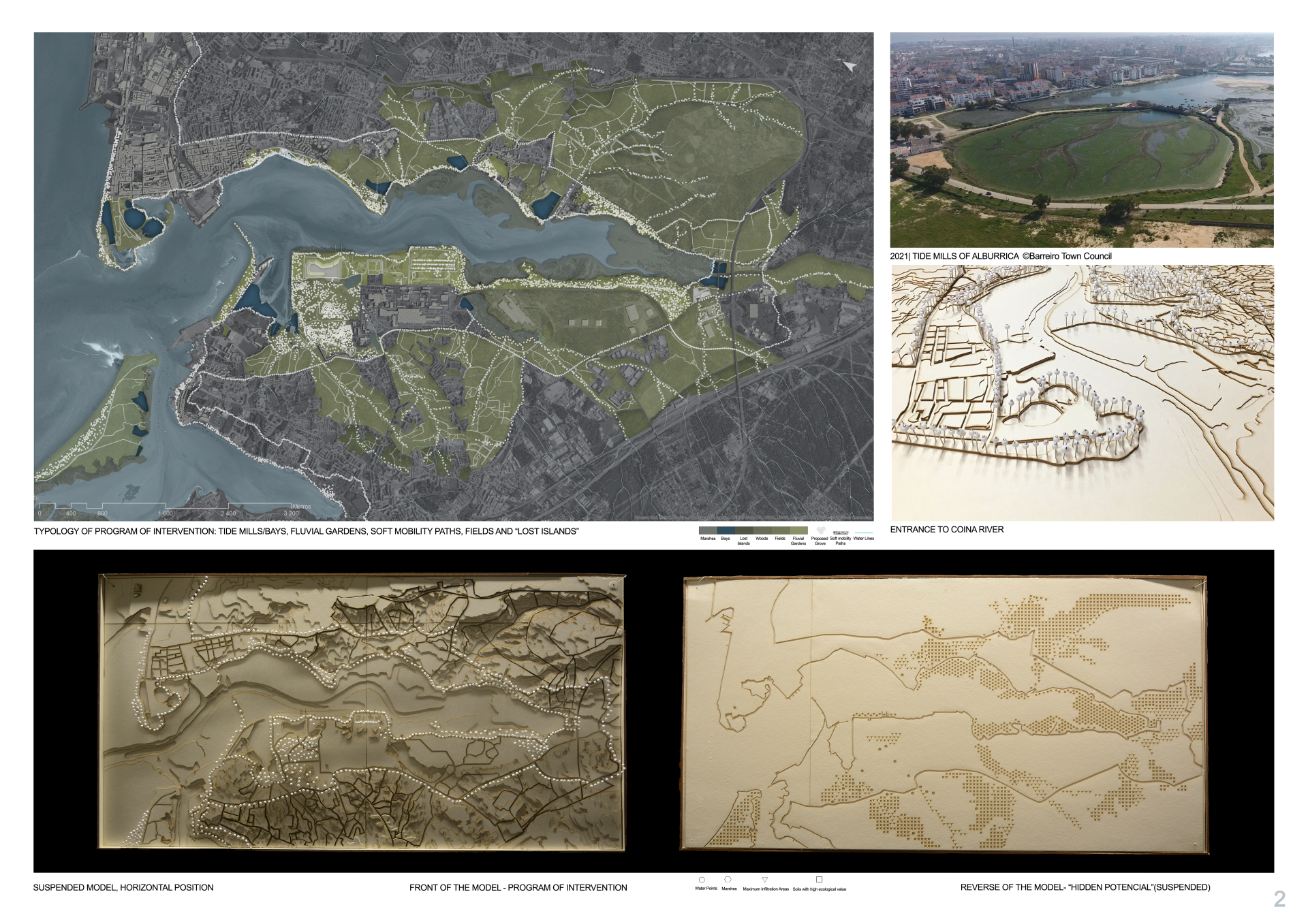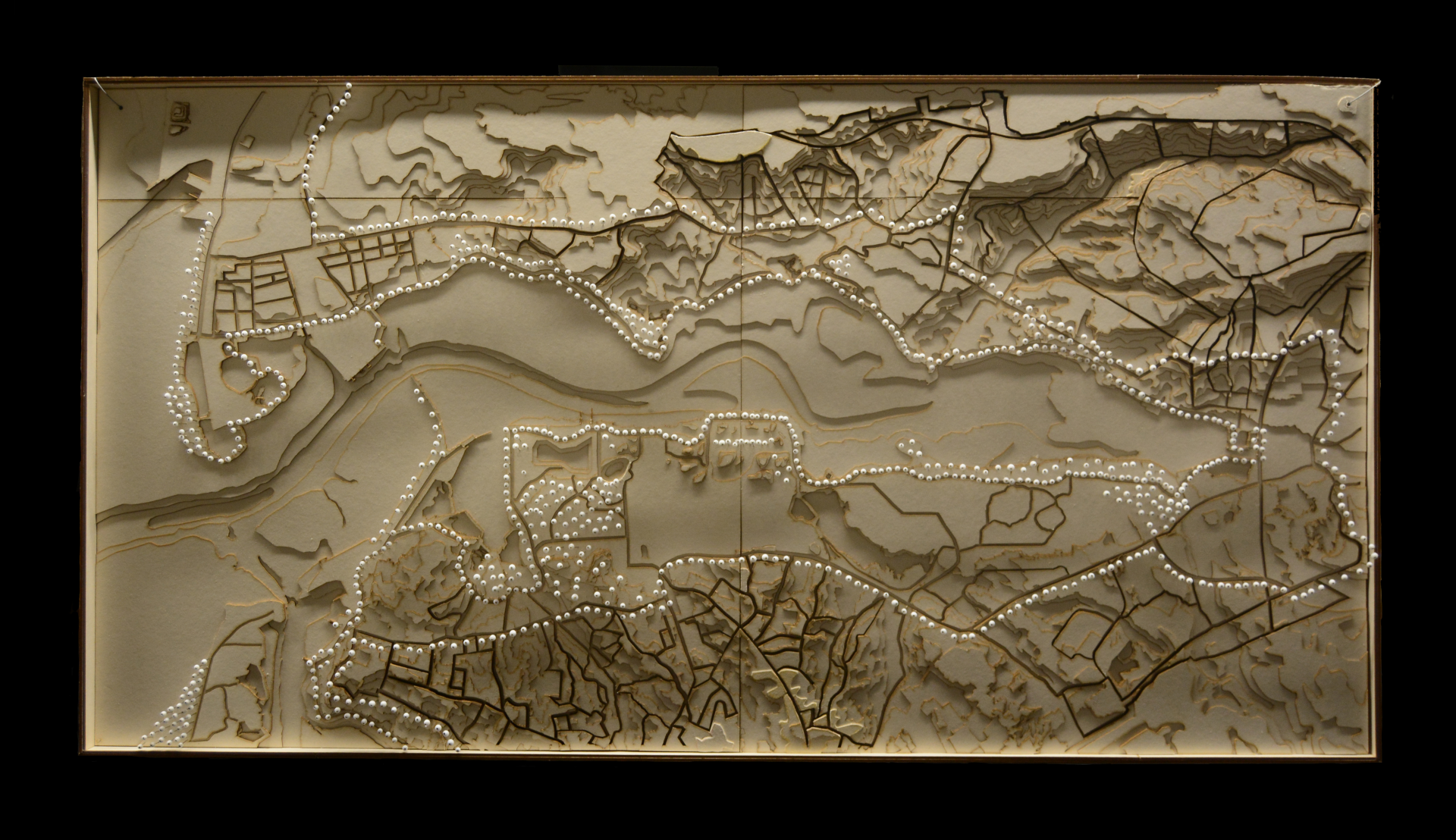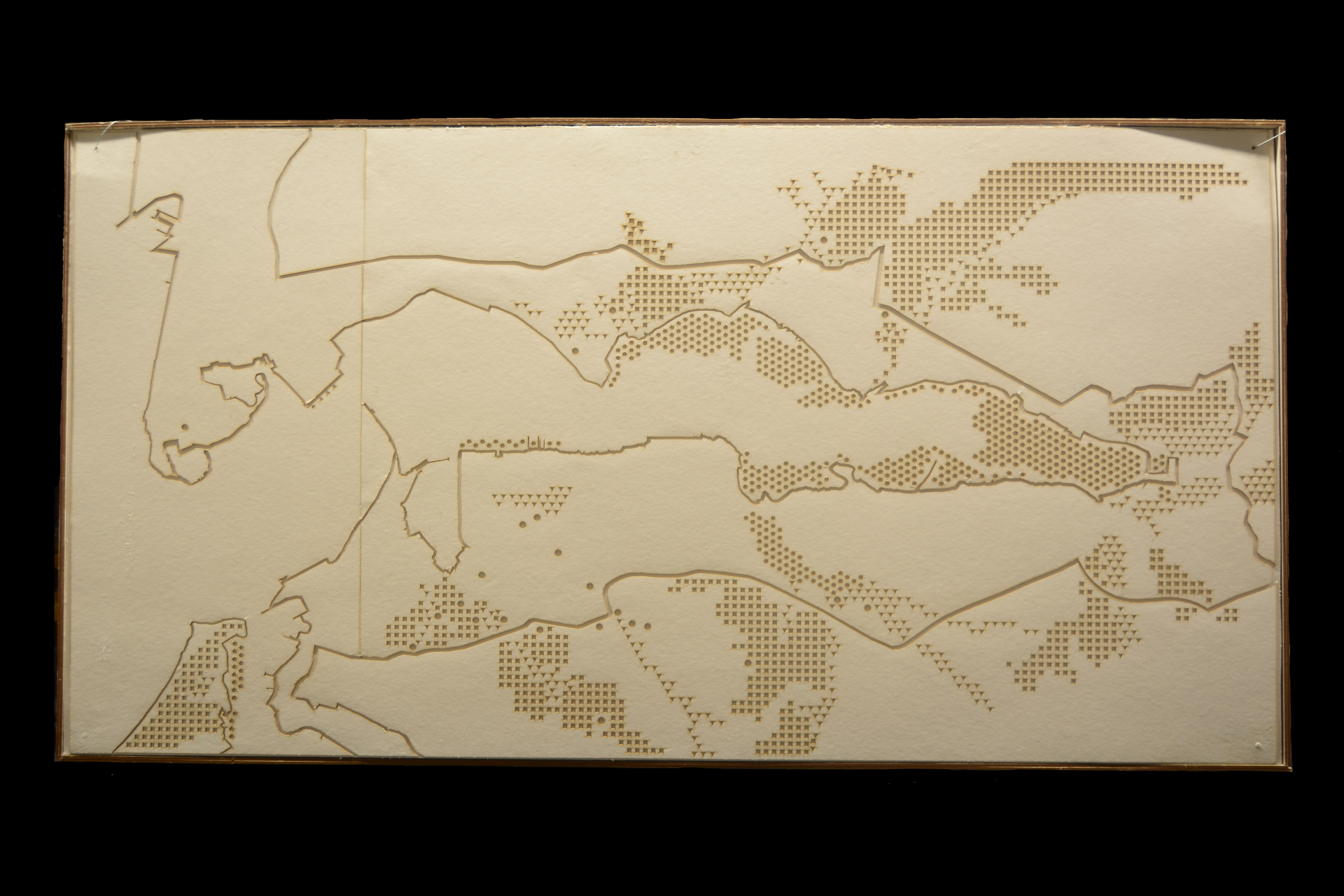The Other Margin
Basic information
Project Title
Category
Project Description
The transformative potential of Barreiro's landscape lies in the permanence and continuity of the river and its margins, structured from natural and human dynamics currently deactivated. "The Other Margin" proposes a singular and dual system that reinterprets Coina’s estuary marginal spaces role in a perspective of reactivation and self-sustainability, from a set of complementary typologies, equating mutual synergies and triggering a Tide Mill System and its bays to reconvert and reintegrate.
Geographical Scope
Project Region
Urban or rural issues
Physical or other transformations
EU Programme or fund
Which funds
Description of the project
Summary
The title "The Other Margin" takes us back to two crucial ideas: parity - one margin of the Coina River in its relationship with the other and the interactions between them. On the other hand, it's a " Margin" of another quality, a linear section of this territory where we want to introduce greater energy to requalify an area of a more comprehensive character. These two attributes are fundamental to be able to stitch together this whole territory, fractioned into fairly recognizable islands, but which are either deactivated or, even if they are active, are often disarticulated. From these two ideas, there's a morphological world associated with the configurations of the river, with the continuity of the river, and there is the meeting of a marginal strip that is the aggregator of all this territory, and there are the particular attributes that the marginal areas have, which are observed in the uses of space and the potentials of these areas. The space also has historical potential. Throughout the various times, the margins are parts of the territory that have always been successively modified, transformed, and questioned. They, therefore, undergo a very intense transformation process that will imply a particular potential of these areas. The concept is developed in a System of Typologies of landscape occupation, to be replicated in spaces of similar nature - morphological condition, relative position and accessibility, soil quality and water presence, biodiversity, spatial relations and configuration. A relationship of complementarity and synergy is fostered in a comprehensive perspective of sustainability - new forms of production and resources, activation of a local economy, social and cultural dynamism, rescue of endangered identities and protection of natural resources.
Key objectives for sustainability
In the sustainability spectrum, we implemented a set of systems, aiming to promote and protect local natural resources.
One of the ideas that formed the basis of our project involves the conversion of old tide mill structures, assuming the implementation of a blue energy production system, from the natural dynamics of the tides - tidal energy. The production has the purpose of local and economic supply. The bays, associated with the mills, form protection systems against climate change and/or natural reservoirs to capture and use local water. They are used as water retention basins, controlling the probable rise in water levels, preventing possible flooding, also containing a phytodepuration system, in order to make the space self-sufficient.
In addition to these fundamental structures, the set of other systems created, form a set of complementary actions that presuppose the profitability and simultaneously protect and promote environmental sustainability and natural resources.
The corridor adjacent to the riverbanks - Fluvial garden system - aims to protect the marsh system, proposing an active recreational space to boost ecological tourism - "nature observatory". In the fields, in addition to producing fresh produce for distribution and local consumption, the high quality agricultural soil is protected and valued. Along the secondary drainage lines, the processes of water retention and infiltration are favored, controlling runoffs and water concentration times, used for irrigation. In the "islands", places of better accessibility, the collection of organic waste is elaborated, contributing to the regeneration and improvement of polluted soils, also fighting erosion.
Finally, a regeneration of the industrial area (referring to the 1/6000 scale drawing in panel number 3), which is currently deactivated, is proposed.
Key objectives for aesthetics and quality
This unique landscape is generated by activities and culture associated with the margin. The records of heritage and dynamics - natural and man-made - give identity to the space, however they're disaggregated and require a physical structure to unite the landscape. Besides the rich and endangered estuary, tide mills and windmills as well as activities related to fish drying, fishing, salt production and agricultural crops such as vines and rice fields are elements that structure the landscape.
In the project the actions taken from the aesthetic point of view pass through the integrated strategic reactivation of the landscape preserving and qualifying existing structures, regenerating and adding local culture to the valences of the margin.
The fluvial dynamics require protection and conservation achieved with the introduction of fluvial gardens which serve as a filter for the dynamics of the marsh. Tide mills and windmills are structures with a high architectural character that continuously mark the landscape. The process of their recovery foresees ways of activating the local economy by attributing new functionalities to the structures leading to a reinterpretation of the existing heritage. The system of fields combats the extinction of agricultural landscape by massive and uncontrolled edification and allows the structuring of the landscape along the slopes. We propose the recuperation of small agricultural units and associated structures (farms and homesteads) contributing to the solidification of heritage and local identity.
Basically, the proposal is based from an aesthetic point of view on the recognition of pre-existing as aggregating elements of the landscape. For example, the pre-existing and re-designed elevations next to the steel industry in the fluvial garden system integrate the proposed parking area. Therefore, the requalification and conservation of these elements guarantee the activation of the space and the aesthetic and architectural continuity.
Key objectives for inclusion
In the project, the concept of inclusion refers to the creation of opportunities, underlying the idea of cyclicality. The set of systems created by the intervention program generates and organizes a new palette of activities along the margin, respecting the conservation and environmental protection strategies. Along Coina river, the opportunities created are diversified, ensuring the activation of younger populations.
The production of local energy: illumination; sustenance of agricultural activities in the fields; activation of the areas of the "lost islands", as spaces of mediation with the surrounding urban system - is a self-sufficient activity, ensuring the sustainable management of natural systems being associated with the bay system and the structures of the tide mills. We propose simple and infrastructural activities, such as equipped sports areas and low maintenance zones.
The creation of activities also involves the organization and management of the site, improving the quality of life at all levels. These activate relationships at the social and economic levels, originating a self-sustainable Margin. Cooperatives or associations for exploitation such as the sale of fresh produce, exploration of tide mills, sale and local use of blue energy, collection and composting of organic waste, tourism/nature observatory, nautical activities and sport fishing, soft means of transport, water management, local capture and purification of rainwater, exchange of services and payment in kind, foster the ideas of inclusion and cycle. These presuppose phased implementations, transversely establishing links between the coastline and the ridges, where there are routes of greater accessibility and forms of soft mobility, along the coastline and softer slopes.
Basically, the idea of inclusion is about creating life opportunities. Assuming the pre-existences, generating diverse activities and reinterpreting uses.
Physical or other transformations
Innovative character
The intervention proposal aggregates the three dimensions of the program: environmental sustainability, aesthetic and quality of experience and social, economic and environmental inclusion.
The landscape is composed by the configurations and continuity of the Coina River, natural realm, and is generated by the activities and culture associated with the margin, which give identity to the space. The intervention program suggests and assumes the implementation of a set of systems and the requalification of existing structures, which act in all aspects of natural dynamics, interconnecting and enriching the proposal. The systems - tide mills/bays, fluvial gardens, fields, "lost islands" - respect pre-existing structures, ensuring patrimonial and aesthetic continuity; they promote and protect living natural resources and compose a margin with a set of new and/or reinvented activities, enablers of social, economic and environmental opportunities.
The project thus involves environmental awareness, patrimonial and aesthetic care, as well as innovation and social inclusion.The margin and a management strategic plan, organization and interaction of the site working through the complementarity of activities created, the development of recreational and sporting spaces and the involvement and collaboration with municipal entities and the municipality - organic waste, energy, fresh produce, water, salt, dried fish.
The project itself also presupposes the intention to operationalize a program with contributions from various disciplinary areas - landscape architects, architects, environmental engineers, hydraulic engineers, among others. The multidisciplinary combination results in an integrated project and, consequently, a holistic plan.

